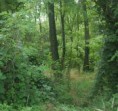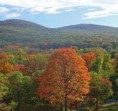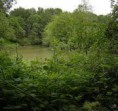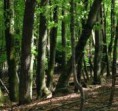
Everything you need to know is right here.
Temperate Evergreen Forest
Vegetation: Dominating trees' eucalyptus, pine, fir, hemlock, spruce, giant sequoia, and cypress.
Description: Temperate evergreen forests are characterized by their hardy trees. Trees need to withstand sandy, rocky, and basically poor quality soil, occasional fires, droughts and cold weather. These forests are generally dominated by pine trees, but also support many other kinds of vegetation. Broad-leaf evergreens dominate forests in eastern Asia, coastal regions of New Zealand and Australia, and parts of Chile. Deciduous trees are found in evergreen forests in the Rocky Mountains. Sequoia's, which are the worlds largest living thing, are found in Kings Canyon National Park in California. Swampy cypress, giant sequoia, and dry pine forests are some of the different types of temperate evergreen forests.-ThickQuest.org
Temperate forests grow in regions that have a wide range of climates, and despite the fact there are fewer plant and animals species than in the rainforest, temperate forests are one of the richest habitats on the planet. Temperate forests contain numerous different animals that live within them and even migratory animals like birds, nest in these forests around the world.
There are two main types of temperate forest, which are deciduous forests and evergreen forests. Deciduous forests can appear to be empty, lifeless places in winter when there are no leaves on the trees but come spring, these forests are bursting with life. Deciduous forests tend to be found in the Northern Hemisphere, in parts of Europe, Japan and North America.
Evergreen forests differ from deciduous forests as the trees don't lose their leaves in the autumn. The evergreen forests are generally seen in warmer climates in southern Europe, South Africa, South America and parts of southern Australia. Evergreen forests tend to have a more varied range of wildlife than the deciduous forests.
A wide variety of animals inhabit these regions of temperate forests around the world including mammals, reptiles, birds and numerous different species of insect. Deer, squirrels and wild boars are the most commonly seen mammals in the deciduous forests, along with birds that nest in the trees. In the far eastern deciduous forests, amphibians such as salamanders can be found in the leaf-litter, and reptiles such as lizards are commonly spotted in the trees.
The wildlife in the evergreen forests, differs greatly from the wildlife in the deciduous forests, mainly due to the fact that food is plentiful in evergreen forests all year round. Lizards and snakes are commonly spotted inhabiting these forests, along with numerous amphibians, birds and insects. In the Australian evergreen forests, marsupials such as koalas and possums can also be found.
It thought that these temperate forests once covered huge areas of the Northern Hemisphere but today the areas of remaining natural forest are few and far between. The main reason for the drastic decline in forests is deforestation, as the trees are cut down for wood (known as logging), or when parts of the forest are cleared to make room for agriculture.-info/FIS
FAQ: Temperate Evergreen Forest
What is the climate for a temperate evergreen forest?
Temperate forests occur in eastern North America, northeastern Asia, and western and central Europe. Well-defined seasons with a distinct winter characterize this forest biome. Moderate climate and a growing season of 140-200 days during 4-6 frost-free months distinguish temperate forests.
Temperature varies from -30° C to 30° C.
Precipitation (75-150 cm) is distributed evenly throughout the year.
Soil is fertile, enriched with decaying litter.
Further subdivisions of this group are determined by seasonal distribution of rainfall:
moist conifer and evergreen broad-leaved forests: wet winters and dry summers (rainfall is concentrated in the winter months and winters are relatively mild).
dry conifer forests: dominate higher elevation zones; low precipitation.
temperate coniferous: mild winters, high annual precipitation (greater than 200 cm).
--- ---
Temperate Forest Facts
|





